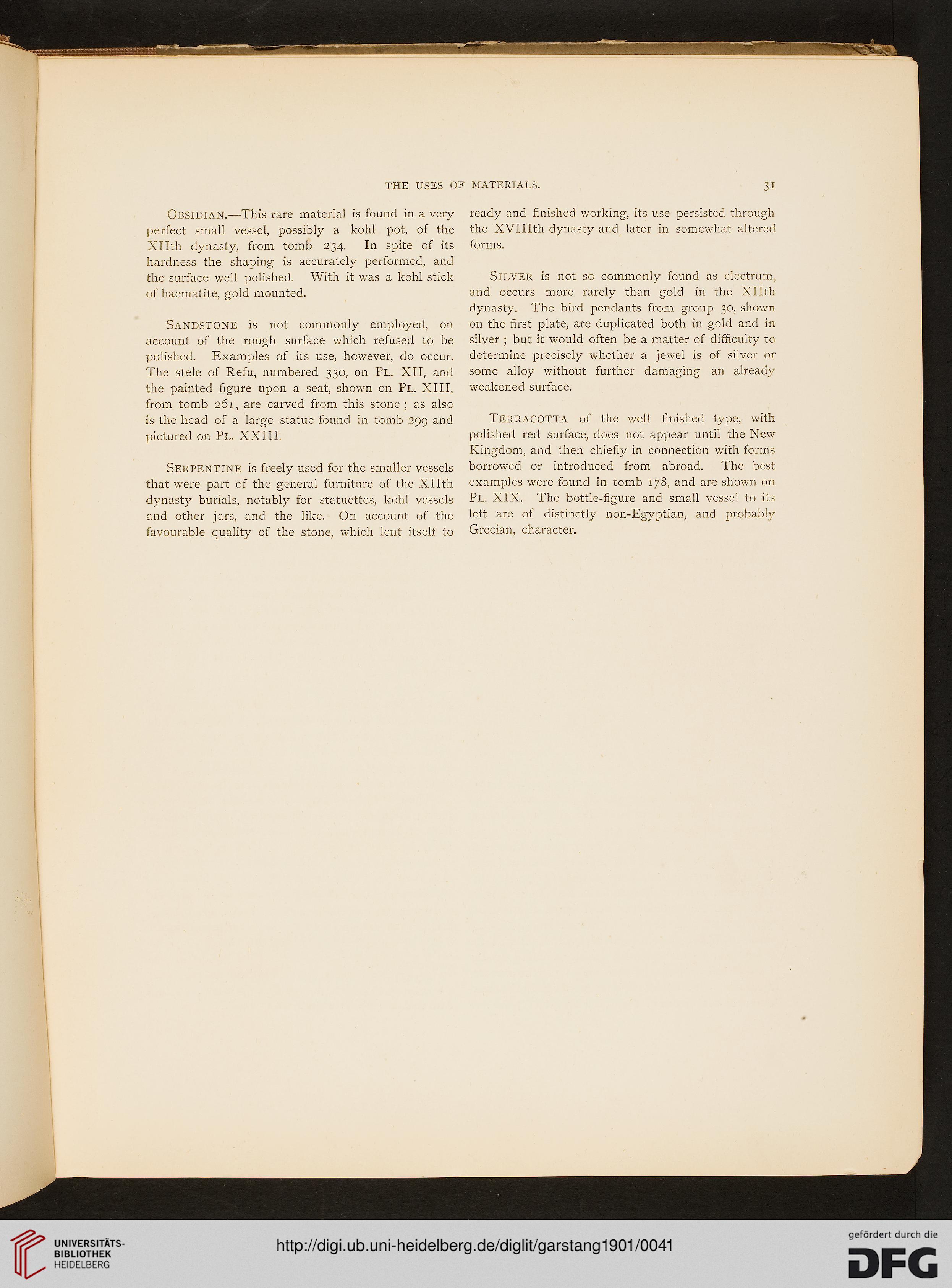THE USES OF MATERIALS.
31
OBSIDIAN.—This rare material is found in a very
perfect small vessel, possibly a kohl pot, of the
Xllth dynasty, from tomb 234. In spite of its
hardness the shaping is accurately performed, and
the surface well polished. With it was a kohl stick
of haematite, gold mounted.
Sandstone is not commonly employed, on
account of the rough surface which refused to be
polished. Examples of its use, however, do occur.
The stele of Refu, numbered 330, on PL. XII, and
the painted figure upon a seat, shown on Pl. XIII,
from tomb 261, are carved from this stone ; as also
is the head of a large statue found in tomb 299 and
pictured on Pl. XXIII.
SERPENTINE is freely used for the smaller vessels
that were part of the general furniture of the Xllth
dynasty burials, notably for statuettes, kohl vessels
and other jars, and the like. On account of the
favourable quality of the stone, which lent itself to
ready and finished working, its use persisted through
the XVIIIth dynasty and later in somewhat altered
forms.
Silver is not so commonly found as electrum.
and occurs more rarely than gold in the Xllth
dynasty. The bird pendants from group 30, shown
on the first plate, are duplicated both in gold and in
silver ; but it would often be a matter of difficulty to
determine precisely whether a jewel is of silver or
some alloy without further damaging an already
weakened surface.
Terracotta of the well finished type, with
polished red surface, does not appear until the New
Kingdom, and then chiefly in connection with forms
borrowed or introduced from abroad. The best
examples were found in tomb 178, and are shown on
PL. XIX. The bottle-figure and small vessel to its
left are of distinctly non-Egyptian, and probably
Grecian, character.
31
OBSIDIAN.—This rare material is found in a very
perfect small vessel, possibly a kohl pot, of the
Xllth dynasty, from tomb 234. In spite of its
hardness the shaping is accurately performed, and
the surface well polished. With it was a kohl stick
of haematite, gold mounted.
Sandstone is not commonly employed, on
account of the rough surface which refused to be
polished. Examples of its use, however, do occur.
The stele of Refu, numbered 330, on PL. XII, and
the painted figure upon a seat, shown on Pl. XIII,
from tomb 261, are carved from this stone ; as also
is the head of a large statue found in tomb 299 and
pictured on Pl. XXIII.
SERPENTINE is freely used for the smaller vessels
that were part of the general furniture of the Xllth
dynasty burials, notably for statuettes, kohl vessels
and other jars, and the like. On account of the
favourable quality of the stone, which lent itself to
ready and finished working, its use persisted through
the XVIIIth dynasty and later in somewhat altered
forms.
Silver is not so commonly found as electrum.
and occurs more rarely than gold in the Xllth
dynasty. The bird pendants from group 30, shown
on the first plate, are duplicated both in gold and in
silver ; but it would often be a matter of difficulty to
determine precisely whether a jewel is of silver or
some alloy without further damaging an already
weakened surface.
Terracotta of the well finished type, with
polished red surface, does not appear until the New
Kingdom, and then chiefly in connection with forms
borrowed or introduced from abroad. The best
examples were found in tomb 178, and are shown on
PL. XIX. The bottle-figure and small vessel to its
left are of distinctly non-Egyptian, and probably
Grecian, character.




